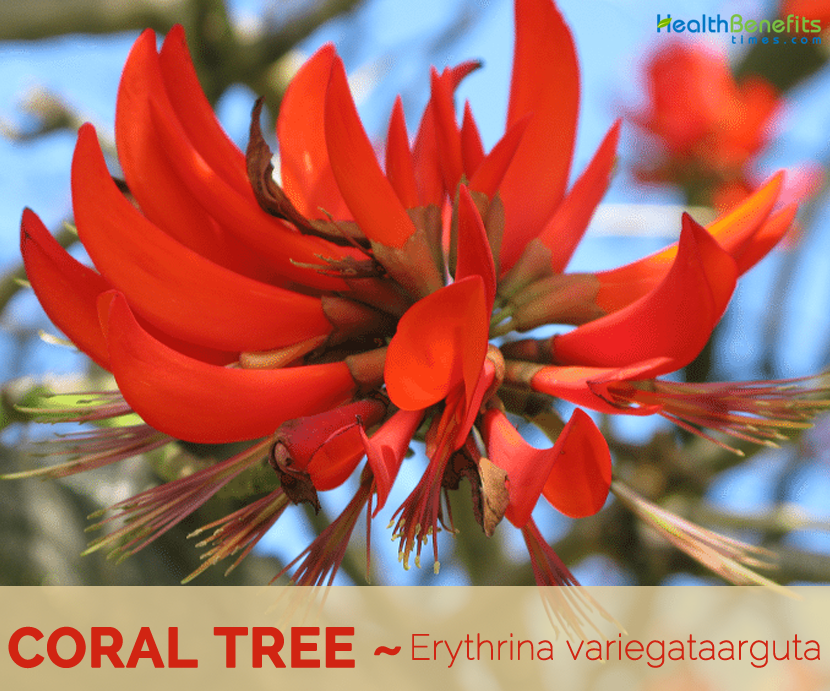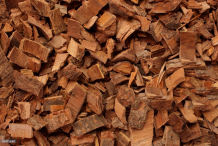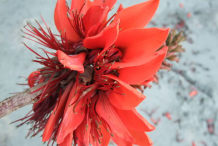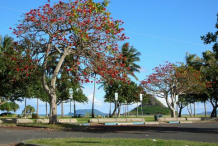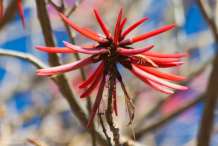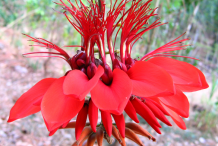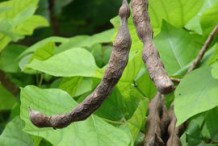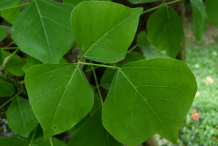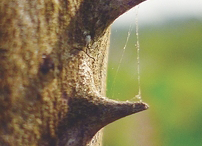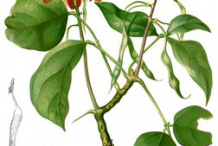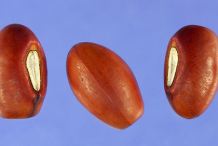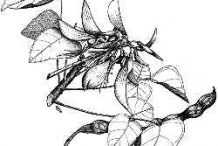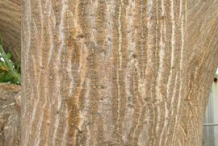| Coral Tree Quick Facts |
| Name: |
Coral Tree |
| Scientific Name: |
Erythrina variegata |
| Origin |
Tropical Asia—from Taiwan and southern China through the Philippines, Indonesia, Malaysia, Thailand |
| Colors |
Black |
| Shapes |
Pods are cylindrical, 10 to 25 centimeters long, 1.5 to 2 centimeters in diameter |
| Taste |
Bitter, acrid |
| Health benefits |
Reduce cholesterol, Help fight obesity, Improve digestive strength, Get relief in liver disorders, Cure women problems, Help cure worm infestation, Relief from fever, Treat swelling and inflammations, Cure anorexia, |
Coral Tree scientifically known as Erythrina variegata is a flowering tree in the family Fabaceae ⁄ Leguminosae (Pea family) native to tropical Asia—from Taiwan and southern China through the Philippines, Indonesia, Malaysia, Thailand, Myanmar, India, islands in the Indian Ocean and all the way to tropical East Africa, the Indian Subcontinent, northern Australia, and the islands of the Indian Ocean and the western Pacific Ocean east to Fiji. Some of the popular common names of the plants are Tiger’s Claw, East Indian Coralbean, Sunshine Tree, Samoan Sunshine Tree, Coral Tree, East Indian Coral Tree, East Indies Coral Tree, Indian Bean Tree, Indian Coral Bean, Indian Coral Tree, Lenten Tree and Mochi Wood Tree. Genus name Erythrina is from the Greek word “erythros” which means “red” and refers to the flowers. Species variegata means irregularly colored and refers to the leaves. It is extensively planted as a street or garden tree in other countries, particularly in California.
Plant Description
Coral tree is an erect, thorny, much branched, medium-sized, deciduous tree that grows about 60-80 ft. (18.3-24.4 m) tall and spread 20-40 ft. (6.1-12.2 m). The tree is found growing in coastal lowland bush and shrub land areas and the dry edges of mangrove forests usually on sandy loams and occurs wild in deciduous forest from the coastal dunes and forests. It thrives best in full sun on a deep, well-drained, sandy loam, but they tolerate a wide range of soil conditions from sands to clays. It can tolerate brief periods of waterlogging. Young bark is smooth-skinned and vertical-striped green, gray, light brown or whitish but becomes spiny when the tree matures. Stem is smooth, greyish with large scattered conical prickles on the stem and branch.
Leaves
Leaves are trifoliate, alternate; rachis is mostly 10–20 cm (4–8 in) long; blades are ovate to rhomboid, 8–18 cm (3.2–7.2 in) long; lateral ones are smaller than the terminal one, petiolules 6–13 mm long, with vegetative parts finely pubescent. Leaflets are triangular to broadly rhomboid-ovate, with acuminate tips and obtuse bases, shining green. They are deciduous just before and during the flowering season, except for “tropic coral,” which has been reported by some authors to not drop its leaves, while other sources have noted its deciduous habit. E. variegata retains its leaves better than other Erythrina species in Hawai’i. Low temperatures, powdery mildew, and/or drought combined with very windy conditions will accelerate leaf drop and retard the development of new leaves.
Flower
Inflorescence of many-flowered fascicles occurs in terminal or axillary racemes up to 20cm (8 in) or more long. Calyx is top-shaped, deeply split along one side, 1–1.8cm (0.4–0.7 in) long, on a pedicel 2–5mm (0.1–0.2 in) long. Corolla is papilionaceous; standard is short-clawed, ovate to sub-elliptic, 3–4cm (1.2–1.6 in) long, red-orange with longitudinal white lines; wings are about half as long as the standard, greenish to pale red; keel is as long as the wings, greenish to pale red. Ovary is superior, stamens 10, diadelphous, with 9 fused together at the base, enclosed within the keel. Flowering is reported from July to November in the southern hemisphere and 6 months later in the northern hemisphere.
Flowering and fruiting are seasonal. Flowering occurs when the tree is leafless in the summer, and fruiting soon follows. Its flowering time was used as a seasonal indicator in some places (e.g., in Samoa its flowering indicated that whales would soon be running in the adjacent ocean).
Fruit
Fruit is black, compressed, narrowly oblong pod 10 to 25 centimeters long and 1.5 to 2 centimeters in diameter, sterile in the basal portion, and not constricted between the 5–10 dark brown seeds. The fruits are ripe from October to November in the Southern Hemisphere and March to April in the Northern Hemisphere, but they often remain on the tree for several months longer.
Seeds
Seeds are kidney-shaped, dark purple to red, and 1–1.5 cm (0.4–0.6 in) in length. These simply fall to the ground and may be washed away (they have been seawater-dispersed over their native range). There are 1450–5000 seeds/kg (660–2270 seeds/lb).
Types
The genus includes 110 species, many of which are cultivated as ornamentals. The only other related species common in the Pacific islands are Erythrina crista-galli, E. fusca, and E. subumbrans. Another species, E. sandwicensis, is endemic to Hawai‘i and is uncommon in cultivation. These can be distinguished from E. variegata and each other as follows:
- E. crista-galli: Easily distinguished from the other three by its flowering much of the year. Its leaves are leathery, dark green, and elliptic (widest toward the middle), and the flowers are rich, dark red.
- E. fusca: This tree occurs naturally in swampy areas. The leaves are oblong to oval in shape, like E. crista-galli, but the flowers are seasonal and dull purple red.
- E. subumbrans: Most distinguishable characteristic of this species is its seed pod, which is constricted at the base (the seeds are formed only in the upper part of the pod), unlike the other four species noted here, and the flowers are greenish to pale red.
- E. variegata: This is the most commonly cultivated member of the genus. Its young stems and other parts are finely hairy, its leaves are mostly ovate (widest toward the base) and sometimes variegated with yellow (var. variegata). Its crimson to orange flowers is 5–8 cm (2–3.2 in) long, and its pod is 5–10 seeded.
- E. sandwicensis: This is similar to E. variegata but has smaller flowers that are 3.5–4 cm (1.4–1.6 in) long and fewer seeds. One to three per pod. E. sandwicensis trunks and main branches have a characteristic orange hue, while E. variegata trunks and branches are whitish gray.
Health benefits of Coral Tree
Coral tree has nothing to do with coral reefs – the name comes from the stunning bright red color of its flowers, which appear on the tree in profusion when it is still without leaves. These flowers stand out starkly against the deeply fissured bark, and present quite a show in the wooded grassland which is its natural habitat. Listed below are some of the health benefits of Coral tree
1. Reduce cholesterol
You can reduce the amount of harmful cholesterol in the blood by including some essence of the leaves of the Indian coral tree to your diet. It flushes out the bad LDL cholesterol and helps augment the heart health. Regular use will make your heart healthy and give you good strength.
2. Improve digestive strength
Decoction prepared from the stem helps to improve the digestion. Take a glass of the decoction before a meal, and this will help improve your appetite. This is considered as one of the best erythrina indica medicinal uses.
3. Help cure worm infestation
People who suffer from worm infestation will get good relief by taking the decoction of the bark daily with their meal. The action of the Indian coral tree is to stun the worms so that they will get flushed out by the natural bowel movement. Have the juice of the leaves daily in the morning on an empty stomach to get the best results.
4. Treat swelling and inflammations
You use the bark to treat rheumatism. Make a paste and apply it to the joints where you have pain and swelling. This will help to make the pain and swelling lesser. You can augment the action by having the decoction of the leaves daily.
5. Cure anorexia
Indian coral tree has wonderful calming nature for the stomach. It helps to cure eating disorders such as anorexia and improve the health of the person. You must take one glass of the decoction made from the leaves or the bark daily before lunch. This will put right any problems you have with your stomach or digestive system.
6. Relief from fever
The Erythrina indica has antipyretic properties so that you can use it to get relief from fevers. Have one glass of the tea prepared from the leaves of the tree twice daily until the fever is gone.
7. Help fight obesity
If you have problems with your weight, you can try using the decoction of the bark of the tree. Powder the bark and boil it in a pan full of water. Wait until the water reduces and then cool it. Filter this and store it for use. Have one cup twice daily and watch your weight decrease fast. This is one of the time tested erythrina indica medicinal uses.
8. Get relief in liver disorders
The plant has good hepato-protective properties. It helps augment the health of the liver by flushing out the toxins. You can have a preparation of the flowers of the Murikki plant and improve the health of the liver. Or, have the decoction of the leaves and benefit. This is one of the effective erythrina indica medicinal uses.
9. Purgative
Leaves and flower of the Indian coral tree find use in making the decoction to clear the stomach. Have the preparation for two to three days in the morning to get good purgative action. It removes all the gas in the intestines.
10. Cure women problems
Preparation of the leaves and bark finds use as a uterine tonic. Women use it when they have delayed periods or amenorrhea.
11. Antiseptic
You can use it to dress wounds due to its antiseptic action. Boil some flowers and leaves in water and let it cool. Then, filter and use the water to clean and dress wounds.
Traditional uses and benefits of Coral Tree
- In Siddha medicine it is used especially for menstrual disorders and fissures at penis tip.
- Wide range of chemical compounds have been isolated, mainly alkaloids, flavonoids, triterpenoids and lectin from E. variegata.
- Different parts of the plant have been used in traditional medicine for a variety of ailments and as nervine sedative, collyrium in ophthalmia, anti-asthmatic, antiepileptic, antiseptic, astringent, febrifuge, anti-bilious, diuretic, laxative, expectorant, anthelmintic, vermifuge and an astringent in Asia and the Pacific Islands.
- Bark is used as a laxative, diuretic, expectorant astringent, febrifuge, anti-bilious and anthelmintic and is useful in ophthalmia and skin diseases.
- Bark is also used to facilitate the maturation of boils.
- Dried bark decoction or infusion in alcohol is used for lumbar and leg pain.
- Stem bark is used against rheumatism in the form of a decoction, extract or tincture and an infusion used for stomachache.
- Bark when crushed and pounded is used for curing toothache by inserting into cavities or hollow tooth.
- Bark is chewed for dysentery.
- Mixture of bark scrapings and lime is applied to reduce swellings.
- Inner bark is scraped and mixed with little water; the juice is squeezed and drunk to cure cough with sore throat.
- Wood is grated in water and given for hematuria.
- Bark and leaves are used in ‘paribhadra’, an Indian preparation as a vermifuge, for treating filariasis, and to relieve joint pain.
- Decoction of the bark and leaves, sweetened, is considered a good expectorant.
- Leaves are used in fever, inflammation and joint pains and as laxative, diuretic and expectorant.
- Heated crushed wet leaves are rubbed over the head and body of a person with fever.
- Juice of the leaves is used in earache, toothache, constipation and cough.
- Consuming the leaves is held to stimulate lactation, appetite and menstruation.
- Extract from crushed leaf mixed with water is drunk to relieve cough.
- Crushed fresh leaves are used externally as a poultice in hemorrhoids and metro ptosis.
- Powdered leaves are topically applied for wounds and ulcers, and a warm poultice is applied externally to relieve rheumatic joints.
- Leaves are described to be sedative and are used for the relief of insomnia and anxiety and for treating asthma.
- Leaves are crushed with seawater and drunk daily to relieve stomachache.
- Honeyed leaf juice is used as vermifuge for tapeworm and roundworm infestations.
- Pulverized leaves in the form of snuff are used for infantile convulsion and ascariasis.
- Leaves mixed with castor oil are used as therapy for dysentery.
- Roots and leaves are considered to be febrifuge.
- Root decoction is used as a gargle for loose and aching teeth and an infusion used for bronchitis.
- Seeds used internally and externally for cancer and externally for abscesses.
- Pounded seeds are used as poultice for snake bites and for abscesses and cancerous growths.
- Decoction of the leaves has been used to treat mastitis.
- An ointment made by boiling the leaves with ripe coconut is applied to venereal buboes and pains in the joints.
- Decoction of the bark and leaves is used to treat dysentery.
- Roots and leaves are often used to alleviate fever.
- Crushed seeds are used to treat cancer and abscesses, and are boiled in a little water as a remedy for snake bites.
Culinary Uses
- Young and old leaves are eaten steamed or stewed as lalab with rice or mixed with other vegetables.
- Leaves are eaten cooked in Papau New Guinea.
- Boiled flowers and young leaves are edible, cooked like string beans but in more water.
- Seeds are consumed after roasting or boiling but are poisonous when eaten raw.
- Leaves of E. variegata are used to wrap ‘nem’ (a kind of fermented pork) in Vietnam.
- Young, tender leaves and young sprouts are eaten as a vegetable and eaten in curries.
Other facts
- It was selected the official flower of Okinawa Prefecture in 1967.
- In Vietnam, the leaves are used to wrap fermented meat.
- Erythrina variegata is a multipurpose tree and an important agroforestry species.
- The species is simultaneously used as leaf forage and medicinal
- It has also proven valuable for fodder production and as sturdy windbreaks.
- It is a useful plant for soil enrichment as it fixes nitrogen, nodulating readily and prolifically in both acid and alkaline soils and is also a good source of organic matter for green manure.
- It is a common ornamental tree for landscape, avenue planting and fencing/hedging purposes in Asia and other tropical countries.
- It is also used as live support tree for black pepper, betel leaf, jasmine, grapes and yams and as a shade tree for coffee and cocoa.
- Soft and white timber has been used for making packing cases, floats, picture frames and toys, and recently pulp for the paper industry.
- Research showed that E. variegata leaf powder could remove metal pollutant from solution.
- Blackened dried leaves are worn for their scent.
- White wood is ground into a powder and used as a face powder.
Precautions
- Seeds of all Erythrina species are reported to be poisonous if ingested.
- Tiger’s claw spines of coral tree can snag clothing and skin.
References:
https://www.itis.gov/servlet/SingleRpt/SingleRpt?search_topic=TSN&search_value=502440#null
https://davesgarden.com/guides/pf/go/78342/
https://npgsweb.ars-grin.gov/gringlobal/taxonomydetail.aspx?id=15773
http://www.theplantlist.org/tpl1.1/record/ild-2735
https://plants.usda.gov/core/profile?symbol=ERVA7
https://en.wikipedia.org/wiki/Erythrina_variegata
https://www.ncbi.nlm.nih.gov/pmc/articles/PMC3249914/
https://www.cabi.org/isc/datasheet/22055
http://priede.bf.lu.lv/ftp/.vg_Daba/201101/Erythrinacoraltree.pdf
Comments
comments


